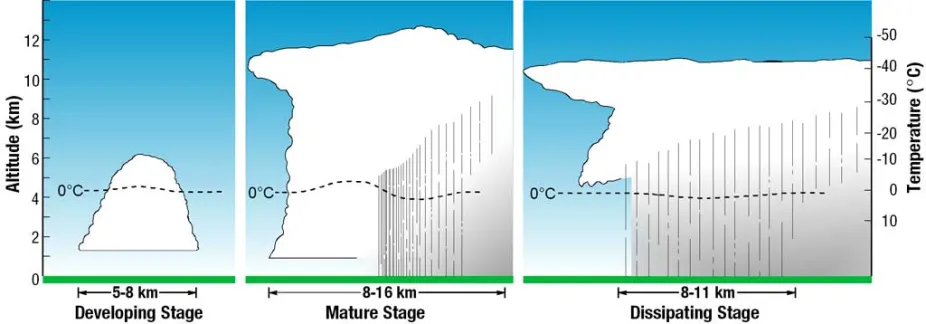How Thunderstorms Form

The developing, mature, and dissipating stages of a thunderstorm.
NOAA
Most thunderstorms form in three stages: the developing stage, when storm clouds form; the mature stage, when the storm is fully formed; and the dissipating stage, when the storm weakens and breaks apart.
The Developing Stage
When warm, moist air moves upward in an updraft, puffy cumulus clouds may form in the atmosphere. The moisture in the air condenses into water droplets as it rises. The cloud will continue to grow as long as warm air from below continues to rise.
There are several ways that an updraft of warm moist air can form. Sometimes air is forced up the side of a mountain. Air is also forced upward at weather fronts, where warm and cool air masses collide. But often, updrafts form without a mountain or front to guide them — just because warm air rises. Air near the ground heats up during the day as energy from the Sun heats the ground, which then heats the air. The warmed air rises higher in the atmosphere because warm air has less mass than cool air, making it lighter.
The Mature Stage
As the cumulus cloud continues to grow, the tiny water droplets within it grow larger as more water from the rising air is added to the droplets. The cloud starts to look dark and gray as more water is added to it, and the growing droplets that make up the cloud become heavy. Raindrops start to fall through the cloud when the rising air can no longer hold them up. Meanwhile, cool dry air flows downward in the cloud, called a downdraft, pulling water down as rain. With an updraft, downdraft, and rain, the cloud is now called a cumulonimbus cloud and the cycling of air up and down is called a thunderstorm cell.
The moving air within the cloud builds up electric charges as it slides past other air. The buildup of electric charges allows lightning to form, much in the same way that you can create a spark after shuffling your feet on a carpet. Thunder is the sound that happens when lightning strikes. It often happens after you see the bolt of lightning because sound travels more slowly than light.
The Dissipating Stage
When the downdrafts in the cloud become stronger than the updrafts, the storm starts to weaken. Since warm moist air can no longer rise, cloud droplets can no longer form. The storm dies out with light rain as the cloud disappears from bottom to top. The whole process takes about one hour for an ordinary thunderstorm. Severe thunderstorms like supercells and squall lines are much larger, more powerful, and last for several hours.